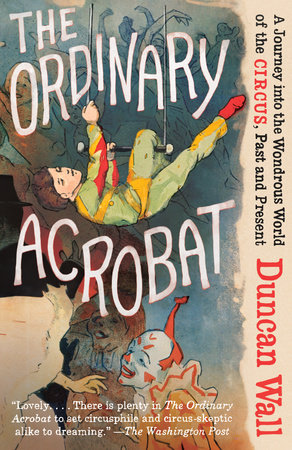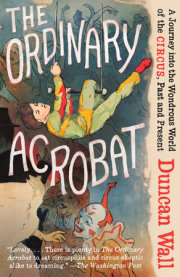I arrived in Paris with vague hopes of being thought of as a student rather than a scholar, a circus hopeful like the others in my program. If asked, I would of course tell the truth, but I honestly thought it wouldn’t come up. Although I wasn’t an acrobat, I was reasonably athletic—-I had excelled at sports as a kid and done some rock--climbing in college. And it was, after all, a “preparatory” program. It would take me less than a class to figure out how hopelessly naïve I was.
Arriving to class early, I spent a few minutes milling around with the other students, making small talk. There were only three of them: Maud, Fanny, and Boris. All were French, all about twenty or so. None were particularly impressive physically. Fanny might have stepped out of a Woodstock poster. Her hair was knotted into dreadlocks, and she wore a ragged wool sweater and a pair of cutoff sweatpants, both of which looked voluminous on her tiny frame. Only slightly taller and thinner, Maud flaunted a tongue ring and a panoply of ear piercings. Boris had broad shoulders and a chiseled jaw, but even he didn’t seem particularly athletic, more like a soldier than an acrobat. In my white Adidas T--shirt and black track pants, I was feeling confident.
After a few minutes, Luc, our paunchy acrobatics professor, arrived. He introduced himself and announced our goal for the day: we would begin with a “reference test,” a simulation of the school’s entrance exam, to gauge our progress over the year. But first, he said, we should take a few minutes to stretch before we got started.
Whereupon I hit my first snag. As I lay there on the ground, arms and legs pitched to the side, the hall lights sparking in my eyes, it occurred to me that I had no idea how an acrobat might stretch. My primary sport while growing up had been soccer, and soccer players don’t worry much about their arms or their necks.
As a temporary solution, I imagined a relief pitcher stretching in a bullpen. I waggled my arm like a dead fish. I pulled my biceps across my chest and gave my arm a good tug. When I had extinguished this line of possibility, I stole a glance over at my cohorts for inspiration. All three of them were gyrating vigorously on the ground, as if engaged in a group Pilates class.
Maud was bouncing her nose toward her knees. Boris had rolled over backward, as if trying to catch a whiff of his crotch, and was alternately popping his legs skyward, then lowering them and squeezing his thighs against his chest. Nearest to me, Fanny lay sprawled on her back, sweeping her legs confidently from side to side—-right over left, left over right. The cuff of her pants made a percussive swishing against the carpet. Swish, swish. Swish, swish.
I decided to give it a shot. Unfolding, as if to make a snow angel, I opened my arms and legs as wide as I could, gave a sigh to expel the air from my lungs, and twisted swiftly at the waist, so that my right leg swept across my left.
Immediately, a series of deeply unhealthy cracking sounds cascaded up my spine—-pop, pop, pop, pop, pop! I had never heard my body make such sounds before. Out of the corner of my eye, I saw Fanny lift her head off the carpet. She eyed me, concerned. “Was that your body?”
I looked at her blankly and shrugged as if I didn’t know what she was talking about. She scrutinized me and then went back to sweeping her legs. I rolled over for some more arm stretches.
It was my first sense that I was out of my league. It would only get worse.
“All right, who wants to go first?”
Stretching complete, Luc had summoned us to the spring--loaded runway, where he lounged on a black cube, a clipboard on his knee. Our “reference test,” he had explained, would consist of a series of acrobatic movements, from basic to difficult. We would have three shots at each. Luc would score each movement: 0 was for not attempting, 5 for perfect. We would start with a basic somersault. “C’mon,” he coaxed again, “somebody has to start.” Maud emerged from our pack.
I had chatted a bit with her before class. She was dainty, with blond hair styled in a pixie cut, a button nose, and green eyes that sparked energetically. She seemed kind and a bit shy. Recounting her experience working as a mascot at Disneyland Paris, she had rolled her eyes, covered her mouth, and laughed an endearing, airy laugh.
But as Maud assumed her position at the head of the runway, there was a demonstrable shift in her demeanor. While Luc repeated the instructions—-three somersaults per pass—-she bounced on her toes and jiggled her arms like a sprinter prepping to settle into the blocks. Gone was tender Maud, the Disneyland Daisy. In her stead was someone darker and fiercer. Toeing the line, she gave a soldierly nod and exhaled sharply, almost snorting. Then she sprang.
It was a spring to behold. With her chin tucked, her toes pointed, and her whole frame taut, Maud arched through the air. Curling just before she hit the ground, she rolled and emerged on her feet, finishing with a little hop, her hands in the air. She paused only momentarily before pouncing again through a second somersault, then a third, each as flawless as the first, like a porpoise cutting waves.
I felt myself shudder. This wasn’t rumpus room; it was Romanian. In the course of her young life, Maud had probably performed hundreds if not thousands of somersaults. To calm myself, I looked to the other students. They seemed unimpressed. Boris had bent over for some toe touches. Fanny was unraveling a loose seam on her sweatpants.
“Next!” called Luc sluggishly
Copyright © 2013 by Duncan Wall. All rights reserved. No part of this excerpt may be reproduced or reprinted without permission in writing from the publisher.








